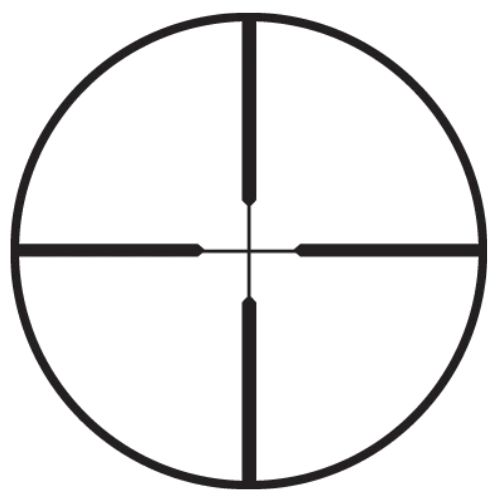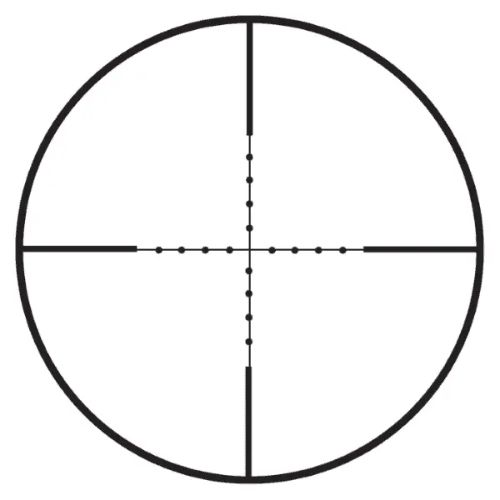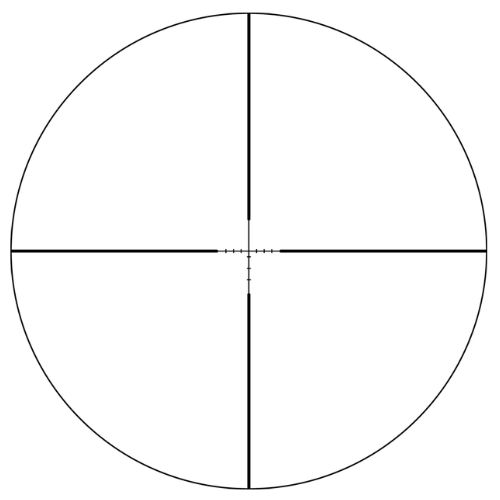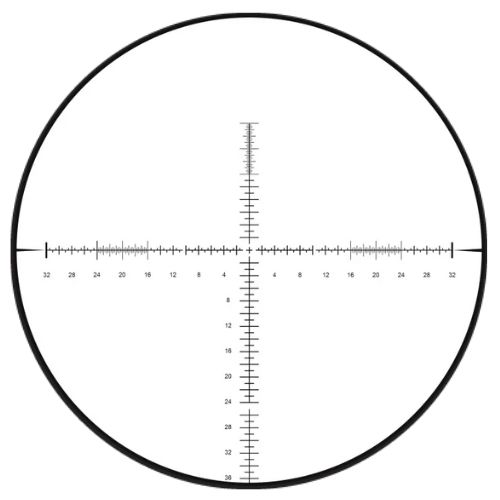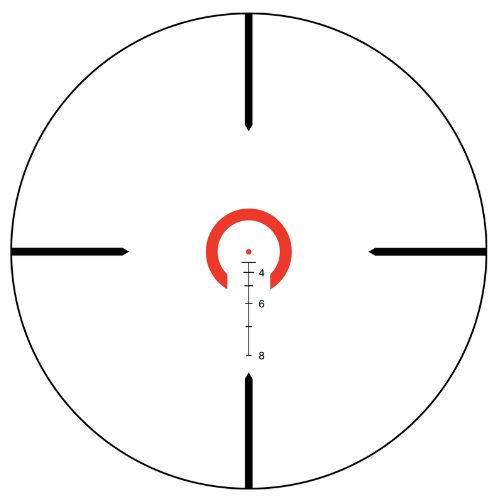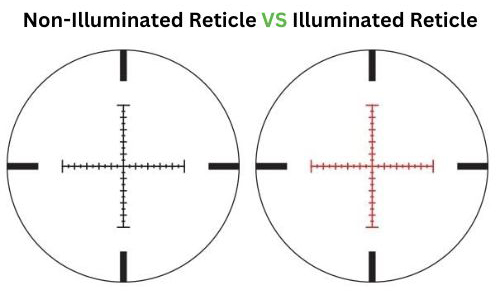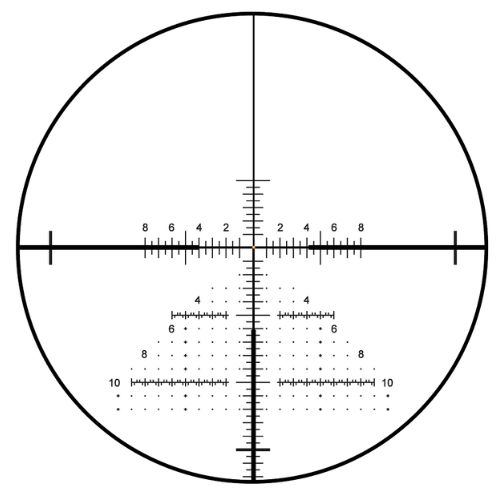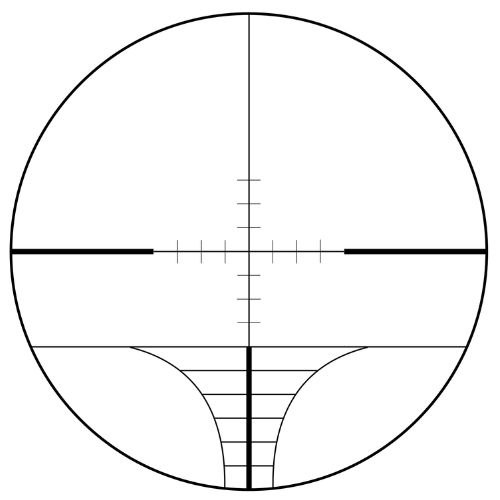A rifle scope reticle (often referred to as a crosshair) is a pattern of lines/markings located inside the eyepiece of a rifle scope. It serves as a visual aid to help shooters aim accurately at their intended target. Reticles come in various designs and configurations, each tailored to different shooting scenarios and preferences. They provide a reference point for aligning the firearm with the target, compensating for factors like bullet drop, windage, and distance.
Common Types of Rifle Scope Reticles:
Duplex Reticle:
This is one of the most straightforward reticle designs. It features thick outer lines that taper towards the centre, forming a cross shape. The thinner centre section allows for precise aiming at smaller targets, while the thicker outer lines aid quick target acquisition.
Mil-Dot Reticle:
This reticle incorporates small dots or markings along the vertical and horizontal lines. These dots are spaced at specific angular intervals, usually one milliradian (mil) apart. Shooters can use these markings to estimate range, holdover, and windage adjustments.
BDC (Bullet Drop Compensation) Reticle:
A BDC reticle includes additional horizontal lines or dots that are spaced at predetermined intervals to compensate for bullet drop at various distances. Each line corresponds to a specific range, allowing the shooter to hold over or under the target accordingly.
MOA (Minute of Angle) Reticle:
Similar to the Mil-Dot reticle, the MOA reticle employs markings in minutes of angle. MOA is another unit for measuring angles, and it's often used to make adjustments for both elevation and windage.
Horseshoe/Dot Reticle:
This reticle combines a central dot with a surrounding horseshoe-shaped pattern. It offers rapid target acquisition and the ability to use the centre dot for precise aiming.
Illuminated Reticle:
Some reticles incorporate illumination, which is particularly useful in low-light conditions. Illumination can come in various colours and brightness settings, improving visibility and contrast against the target.
Christmas Tree Reticle:
This advanced reticle design is commonly found in long-range precision scopes. It features a series of horizontal and vertical hash marks resembling a Christmas tree, allowing shooters to make precise elevation and windage adjustments.
Rangefinder Reticle:
These reticles integrate built-in rangefinding features, helping shooters estimate the distance to the target by measuring the target's size in relation to the reticle's markings.
Reticles are chosen based on the shooter's preferences, shooting discipline, and the intended use of the rifle. Different reticles offer varying levels of complexity and precision, so it's essential to select a reticle that aligns with your shooting style and the distances you intend to engage targets at.
Difference between Dead-Hold BDC & Straight-Wall BDC:
Dead-Hold BDC Reticle:
Purpose:
Designed to minimize guesswork on hold-over at long distances, making it versatile for various firearms, including high-powered rifles, slug shotguns, black powder rifles, and rimfire rifles.
Design:
Features multiple hash marks along the vertical axis, allowing shooters to compensate for bullet drop at extended ranges. This design aids in accurate shooting without the need for complex calculations.
Calibration:
While it provides general guidance, optimal accuracy is achieved when calibrated to the specific ballistic profile of the ammunition being used.
Straight-Wall BDC Reticle:
Purpose:
Specifically optimized for straight-wall cartridges, which are popular in certain hunting regions due to legal restrictions. Common calibres include .450 Bushmaster, .45-70 Government, .350 Legend, and .400 Legend.
Design:
Incorporates hold-over points calibrated to match the unique ballistic drop of straight-wall cartridges, enhancing down-range accuracy for these specific rounds.
Calibration:
Pre-calibrated for straight-wall cartridges, allowing shooters to use the reticle effectively without additional adjustments.
Key Differences:
Versatility:
The Dead-Hold BDC is versatile across various firearms and calibres, whereas the Straight-Wall BDC is specialized for straight-wall cartridges.
Calibration:
The Dead-Hold BDC may require calibration to match specific ammunition, while the Straight-Wall BDC comes pre-calibrated for its intended cartridges.
FFP VS SFP
FFP (First Focal Plane):
What it is:
FFP refers to the position of the reticle inside the scope. In FFP scopes, the reticle scales with magnification.
How it works:
As you zoom in or out, the reticle grows or shrinks proportionally with the target. This means the hash marks or dots on the reticle (like MOA or MILDOT) remain accurate at all magnification levels.
Usage:
This is great for long-range shooting because you can use the reticle for range estimation and holdovers regardless of magnification.
Why it matters:
FFP is ideal for situations where you need to engage targets at varying distances using different magnification settings.
SFP (Second Focal Plane):
What it is:
In SFP scopes, the reticle stays the same size, regardless of magnification.
How it works:
The reticle doesn't change size as you zoom in or out, which means the spacing between the hash marks or dots is only accurate at one specific magnification (usually the highest).
Usage:
SFP is more common in hunting scopes and is simpler for shooters who prefer not to have their reticle size change when zooming.
Why it matters:
SFP scopes are often preferred for their consistent reticle size, but you need to remember the magnification setting where the reticle measurements are correct.

